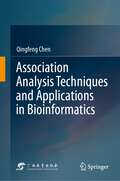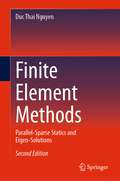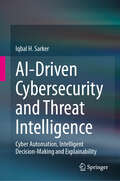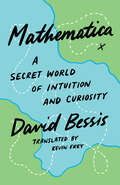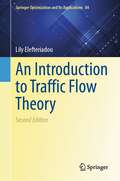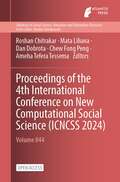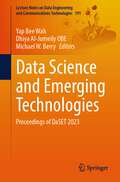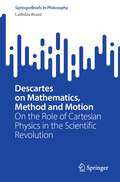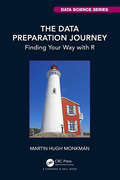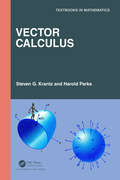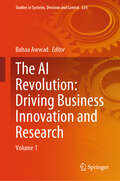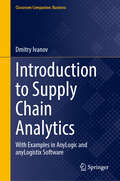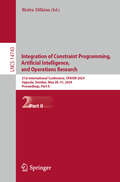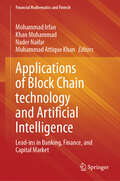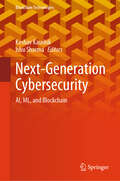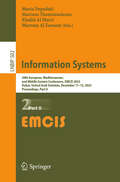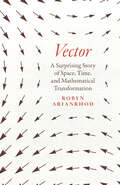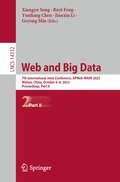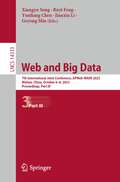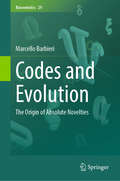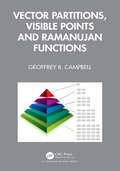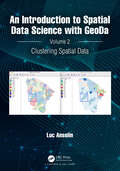- Table View
- List View
Association Analysis Techniques and Applications in Bioinformatics
by Qingfeng ChenAdvances in experimental technologies have given rise to tremendous amounts of biology data. This not only offers valuable sources of data to help understand biological evolution and functional mechanisms, but also poses challenges for accurate and effective data analysis. This book offers an essential introduction to the theoretical and practical aspects of association analysis, including data pre-processing, data mining methods/algorithms, and tools that are widely applied for computational biology. It covers significant recent advances in the field, both foundational and application-oriented, helping readers understand the basic principles and emerging techniques used to discover interesting association patterns in diverse and heterogeneous biology data, such as structure-function correlations, and complex networks with gene/protein regulation. The main results and approaches are described in an easy-to-follow way and accompanied by sufficientreferences and suggestions for future research. This carefully edited monograph is intended to provide investigators in the fields of data mining, machine learning, artificial intelligence, and bioinformatics with a profound guide to the role of association analysis in computational biology. It is also very useful as a general source of information on association analysis, and as an overall accompanying course book and self-study material for graduate students and researchers in both computer science and bioinformatics.
Finite Element Methods: Parallel-Sparse Statics and Eigen-Solutions
by Duc Thai NguyenThis new edition includes three new chapters, 7 through 9, that have very broad, practical applications in engineering and science. In addition, the author’s latest research results incorporated into the new textbook demonstrates better performance than the popular METIS software for partitioning graphs, partitioning finite element meshes, and producing fill-reducing orderings for sparse matrices. The new Chapter 8, and its pre-requisite, Chapter 7, present a state-of-the-art algorithm for computing the shortest paths for real-life (large-scale) transportation networks with minimum computational time. This approach has not yet appeared in any existing textbooks and it could open the doors for other transportation engineering applications. Chapter 9 vastly expands the scope of the previous edition by including sensitivity (gradient) computation and MATLAB’s built-in function “fmincon” for obtaining the optimum (or best) solution for general engineering problems.
AI-Driven Cybersecurity and Threat Intelligence: Cyber Automation, Intelligent Decision-Making and Explainability
by Iqbal H. SarkerThis book explores the dynamics of how AI (Artificial Intelligence) technology intersects with cybersecurity challenges and threat intelligence as they evolve. Integrating AI into cybersecurity not only offers enhanced defense mechanisms, but this book introduces a paradigm shift illustrating how one conceptualize, detect and mitigate cyber threats. An in-depth exploration of AI-driven solutions is presented, including machine learning algorithms, data science modeling, generative AI modeling, threat intelligence frameworks and Explainable AI (XAI) models. As a roadmap or comprehensive guide to leveraging AI/XAI to defend digital ecosystems against evolving cyber threats, this book provides insights, modeling, real-world applications and research issues. Throughout this journey, the authors discover innovation, challenges, and opportunities. It provides a holistic perspective on the transformative role of AI in securing the digital world.Overall, the useof AI can transform the way one detects, responds and defends against threats, by enabling proactive threat detection, rapid response and adaptive defense mechanisms. AI-driven cybersecurity systems excel at analyzing vast datasets rapidly, identifying patterns that indicate malicious activities, detecting threats in real time as well as conducting predictive analytics for proactive solution. Moreover, AI enhances the ability to detect anomalies, predict potential threats, and respond swiftly, preventing risks from escalated. As cyber threats become increasingly diverse and relentless, incorporating AI/XAI into cybersecurity is not just a choice, but a necessity for improving resilience and staying ahead of ever-changing threats. This book targets advanced-level students in computer science as a secondary textbook. Researchers and industry professionals working in various areas, such as Cyber AI, Explainable and Responsible AI, Human-AI Collaboration, Automation and Intelligent Systems, Adaptive and Robust Security Systems, Cybersecurity Data Science and Data-Driven Decision Making will also find this book useful as reference book.
Mathematica: A Secret World of Intuition and Curiosity
by David BessisA fascinating look into how the transformative joys of mathematical experience are available to everyone, not just specialists Math has a reputation for being inaccessible. People think that it requires a special gift or that comprehension is a matter of genes. Yet the greatest mathematicians throughout history, from René Descartes to Alexander Grothendieck, have insisted that this is not the case. Like Albert Einstein, who famously claimed to have “no special talent,” they said that they had accomplished what they did using ordinary human doubts, weaknesses, curiosity, and imagination. David Bessis guides us on an illuminating path toward deeper mathematical comprehension, reconnecting us with the mental plasticity we experienced as children. With simple, concrete examples, Bessis shows how mathematical comprehension is integral to the great learning milestones of life, such as learning to see, to speak, to walk, and to eat with a spoon. Focusing on the deeply human roots of mathematics, Bessis dispels the myths of mathematical genius. He offers an engaging initiation into the experience of math not as a series of discouragingly incomprehensible logic problems but as a physical activity akin to yoga, meditation, or a martial art. This perspective will change the way you think not only about math but also about intelligence, intuition, and everything that goes on inside your head.
An Introduction to Traffic Flow Theory (Springer Optimization and Its Applications #84)
by Lily ElefteriadouThis second edition of An Introduction to Traffic Flow Theory adds new material in several chapters related to advanced technologies including autonomy, the use of sensors and communications, and particularly congestion mitigation solutions that leverage connected and autonomous vehicles (CAVs). It also includes a new chapter that briefly outlines several mathematical analysis techniques commonly used in traffic flow theory, aiming to introduce students to some of the most frequently used tools available for traffic operational-related analysis. This new edition also includes several updates related to the most recent versions of the Highway Capacity Manual and the Green Book. This textbook is meant for use in advanced undergraduate/graduate level courses in traffic flow theory with prerequisites including two semesters of calculus, statistics, and an introductory course in transportation. The text would also be of interest to transportation professionals as a refresherin traffic flow theory or as a reference. Students and engineers of diverse backgrounds will find this text accessible and applicable to today’s traffic issues.This text provides a comprehensive and concise treatment of the topic of traffic flow theory and includes several topics relevant to today’s highway transportation system. It provides the fundamental principles of traffic flow theory as well as applications of those principles for evaluating specific types of facilities (freeways, intersections, etc.). Newer concepts of Intelligent transportation systems (ITS) and their potential impact on traffic flow are discussed. State-of-the-art traffic flow research, microscopic traffic analysis, and traffic simulation have significantly advanced and are also discussed in this text. Real-world examples and useful problem sets complement each chapter.
Proceedings of the 4th International Conference on New Computational Social Science (Advances in Social Science, Education and Humanities Research #844)
This is an open access book. Welcome to The 4th International Conference on New Computational Social Science which will be held on March 08-10, 2024, Shenzhen, Guangdong, China. The focus of this conference are mainly five aspects: Big data acquisition and analysis, Integration of qualitative research and quantitative research, Sociological Internet experiment research, Application of ABM simulation method in Sociology Research, Research and development of new social computing tools. With the rapid development of information technology, especially sweeping progress in the Internet of things, cloud computing, social networks, social media and big data. As a data-intensive science, social computing is an emerging thing that leverages the capacity to collect and analyze data with an unprecedented breadth, depth and scale. It represents a new computing paradigm and an interdisciplinary research and application field. A broad comprehension of major topics involved in social computing is important for both scholars and practitioners. This is an international conference on vary research aspects of Computational Social Science. We will present and discuss key concepts and analyze state-of-the-art of the field. The conference not only sheds insights on social computing, but also affords conduit for future research in the field. Social computing has two distinct trends: One is on the social science issues, such as computational social science, computational sociology, social network analysis, etc; The other is on the use of computational techniques, such as social use, hedonic use and generative use. Finally some new challenges ahead are summarized, including interdisciplinary cooperation and training, big data sharing for scientific data mashups, and privacy protect.
Data Science and Emerging Technologies: Proceedings of DaSET 2023 (Lecture Notes on Data Engineering and Communications Technologies #191)
by Michael W. Berry Yap Bee Wah Dhiya Al-Jumeily OBEThe book presents selected papers from International Conference on Data Science and Emerging Technologies (DaSET 2023), held online at UNITAR International University, Malaysia during December 4–5, 2023. This book presents current research and applications of data science and emerging technologies. The topics covered are artificial intelligence, big data technology, machine and deep learning, data mining, optimization algorithms, blockchain, Internet of Things (IoT), cloud computing, computer vision, cybersecurity, augmented and virtual reality, cryptography, and statistical learning.
Descartes on Mathematics, Method and Motion: On the Role of Cartesian Physics in the Scientific Revolution (SpringerBriefs in Philosophy)
by Ladislav KvaszThis book argues that Descartes’ physics was a milestone on the road to modern mathematical physics. After Newton introduced a completely different approach to mathematical description of motion, Descartes’ physics became obsolete and even difficult to comprehend. This text follows the language of Descartes and the means of which motion can be described. It argues that Descartes achieved almost everything that later Newton was able to do—to describe the motion of interacting bodies- by different (i.e. algebraic) means. This volume completely refutes the received view according to which Descartes’ physics was merely a kind of discursive natural philosophy. To make this interpretation more plausible the book follows Descartes’ ideas from his early work in mathematics, through his invention of the analytic method towards his mature physics. It shows that Descartes followed a similar heuristic pattern.The volume appeals to students and researchers; it invites the reader equippedwith minimal understanding of college mathematics to follow Descartes on his intellectual journey through the Scientific Revolution. The reader will gain a deeper understanding of the role of mathematical language in the creation of modern physics and a glimpse into the fascinating world of Descartes’ scientific thought. Several of Descartes’ philosophical ideas can be traced back to his scientific interests and thus the book elucidates the motivation behind some of Descartes’ key positions in the area of epistemology and method. In the penultimate chapter the book presents four arguments in favor of seeing Descartes as a physicist on par with Galileo and Newton.
The Data Preparation Journey: Finding Your Way with R (Chapman & Hall/CRC Data Science Series)
by Martin Hugh MonkmanThe Data Preparation Journey: Finding Your Way With R introduces the principles of data preparation within in a systematic approach that follows a typical data science or statistical workflow. With that context, readers will work through practical solutions to resolving problems in data using the statistical and data science programming language R. These solutions include examples of complex real-world data, adding greater context and exposing the reader to greater technical challenges. This book focuses on the Import to Tidy to Transform steps. It demonstrates how “Visualise” is an important part of Exploratory Data Analysis, a strategy for identifying potential problems with the data prior to cleaning.This book is designed for readers with a working knowledge of data manipulation functions in R or other programming languages. It is suitable for academics for whom analyzing data is crucial, businesses who make decisions based on the insights gleaned from collecting data from customer interactions, and public servants who use data to inform policy and program decisions. The principles and practices described within The Data Preparation Journey apply regardless of the context.Key Features: Includes R package containing the code and data sets used in the book Comprehensive examples of data preparation from a variety of disciplines Defines the key principles of data preparation, from access to publication
The Data Preparation Journey: Finding Your Way with R (Chapman & Hall/CRC Data Science Series)
by Martin Hugh MonkmanThe Data Preparation Journey: Finding Your Way With R introduces the principles of data preparation within in a systematic approach that follows a typical data science or statistical workflow. With that context, readers will work through practical solutions to resolving problems in data using the statistical and data science programming language R. These solutions include examples of complex real-world data, adding greater context and exposing the reader to greater technical challenges. This book focuses on the Import to Tidy to Transform steps. It demonstrates how “Visualise” is an important part of Exploratory Data Analysis, a strategy for identifying potential problems with the data prior to cleaning.This book is designed for readers with a working knowledge of data manipulation functions in R or other programming languages. It is suitable for academics for whom analyzing data is crucial, businesses who make decisions based on the insights gleaned from collecting data from customer interactions, and public servants who use data to inform policy and program decisions. The principles and practices described within The Data Preparation Journey apply regardless of the context.Key Features: Includes R package containing the code and data sets used in the book Comprehensive examples of data preparation from a variety of disciplines Defines the key principles of data preparation, from access to publication
Vector Calculus (Textbooks in Mathematics)
by Harold Parks Steven G. KrantzUsing meaningful examples, credible applications, and incisive technology, Vector Ca1culus strives to empower students, enhance their critical thinking skills, and equip them with the knowledge and skills to succeed in the major or discipline they ultimately choose to study. This text is intended to be a cornerstone of that process. An engaging style and clear writing make the language of mathematics accessible, understandable, and enjoyable, with a high standard for mathematical rigor.A calculus book must tell the truth. This book is carefully written in the accepted language of mathematics in a readable exposition. It includes useful and fascinating applications, acquaints students with the history of the subject, and offers a sense of what mathematics is all about.Technique is presented, yet so are ideas. The authors help students to master basic methods and discover and build their own concepts in a scientific subject. There is an emphasis on using modeling and numerical calculation. Additional features include: A Quick Quiz and Problems for Practice, Further Theory and Practice, and Calculator/Computer Exercises appear at the end of each section. All exercise sets are step laddered. A Look Back and A Look Forward help students put the ideas in context. Every chapter ends with a Genesis and Development section, giving history and perspective on key topics in the evolution of calculus. Boxed Insights clear up points or answer commonly asked questions. The text has an extra-large offering of examples. Examples are illustrated with meaningful and useful graphics. The pedagogical features make the subject more interesting and accessible to students than other texts, while maintaining an appropriate rigor. —Daniel Cunningham, CSU-Fresno This text is truly well written and organized. I do like the fact the book is quite rigorous, yet full of illustrative examples. —Bob Devaney, Boston University
Vector Calculus (Textbooks in Mathematics)
by Harold Parks Steven G. KrantzUsing meaningful examples, credible applications, and incisive technology, Vector Ca1culus strives to empower students, enhance their critical thinking skills, and equip them with the knowledge and skills to succeed in the major or discipline they ultimately choose to study. This text is intended to be a cornerstone of that process. An engaging style and clear writing make the language of mathematics accessible, understandable, and enjoyable, with a high standard for mathematical rigor.A calculus book must tell the truth. This book is carefully written in the accepted language of mathematics in a readable exposition. It includes useful and fascinating applications, acquaints students with the history of the subject, and offers a sense of what mathematics is all about.Technique is presented, yet so are ideas. The authors help students to master basic methods and discover and build their own concepts in a scientific subject. There is an emphasis on using modeling and numerical calculation. Additional features include: A Quick Quiz and Problems for Practice, Further Theory and Practice, and Calculator/Computer Exercises appear at the end of each section. All exercise sets are step laddered. A Look Back and A Look Forward help students put the ideas in context. Every chapter ends with a Genesis and Development section, giving history and perspective on key topics in the evolution of calculus. Boxed Insights clear up points or answer commonly asked questions. The text has an extra-large offering of examples. Examples are illustrated with meaningful and useful graphics. The pedagogical features make the subject more interesting and accessible to students than other texts, while maintaining an appropriate rigor. —Daniel Cunningham, CSU-Fresno This text is truly well written and organized. I do like the fact the book is quite rigorous, yet full of illustrative examples. —Bob Devaney, Boston University
The AI Revolution: Volume 1 (Studies in Systems, Decision and Control #524)
by Bahaa AwwadThis comprehensive book explores the transformative role of artificial intelligence (AI) in business innovation and research. It provides a solid foundation in AI technologies, such as machine learning, natural language processing, and computer vision, and examines how they reshape business models and revolutionize industries. The book highlights the strategic implications of AI in enhancing customer experience, optimizing operations, and enabling data-driven decision-making. It explores the integration of AI with emerging trends like IoT, blockchain, and cloud computing for innovation. The role of AI in advancing scientific discovery and academic research is also explored, addressing challenges and opportunities in AI-driven methodologies. Organizational and ethical dimensions of AI implementation are considered, including talent acquisition, skills development, and data governance. Real-world case studies showcase AI's transformative power across diverse industries. This forward-thinking guide equips academics, researchers, and business leaders with knowledge and insights to harness the potential of AI and contribute to innovation and research.
Introduction to Supply Chain Analytics: With Examples in AnyLogic and anyLogistix Software (Classroom Companion: Business)
by Dmitry IvanovThe book offers a concise yet comprehensive introduction to supply chain analytics covering management, modeling, and technology perspectives. Designed to accompany the textbook “Global Supply Chain and Operations Management”, it addresses the topics of supply chain analytics in more depth. The book describes descriptive, predictive, and prescriptive supply chain analytics explaining methodologies, illustrating method applications with the use of training exercises, and providing numerous examples in AnyLogic and anyLogistix software. Throughout the book, numerous practical examples and short case studies are given to illustrate theoretical concepts. Along with AnyLogic and anyLogistix model development guidelines and examples, the book has two other distinct features. First, it reviews and explains novel frameworks and concepts related to data-driven decision-making and digital twins. Second, it shows how to use analytics to improve supply chain resilience.Without relying heavily on mathematical derivations, the book offers a structured presentation and explanation of major supply chain analytics techniques and principles in a simple, predictable format to make it easy to understand for students and professionals with both management and engineering backgrounds. Graduate/Ph.D. students and supply chain professionals alike would benefit from a structured and didactically-oriented concise presentation of the concepts, principles, and methods of supply chain analytics. Providing graduate students and supply chain managers with working knowledge of basic and advanced supply chain analytics, this book contributes to improving knowledge-awareness of decision-making in increasingly data-driven and digital environments. The book is supplemented by a companion website offering interactive exercises with the use of AnyLogic and anyLogistix software as well as Spreadsheet Modeling.
Integration of Constraint Programming, Artificial Intelligence, and Operations Research: 21st International Conference, CPAIOR 2024, Uppsala, Sweden, May 28–31, 2024, Proceedings, Part II (Lecture Notes in Computer Science #14743)
by Bistra DilkinaThis book constitutes the proceedings of the 21st International Conference on the Integration of Constraint Programming, Artificial Intelligence, and Operations Research, CPAIOR 2024, held in Uppsala, Sweden, during May 28–31, 2024.The 33 full papers and the 9 short papers presented in the proceedings were carefully reviewed and selected from a total of 104 submissions. The content of the papers focus on new techniques or applications in the area and foster the integration of techniques from different fields dealing with large and complex problems.
Applications of Block Chain technology and Artificial Intelligence: Lead-ins in Banking, Finance, and Capital Market (Financial Mathematics and Fintech)
by Mohammad Irfan Khan Muhammad Muhammad Attique Khan Nader NaifarToday, emerging technologies offer a new pathway for advancing the economy in the fields of banking, finance, and capital markets. Blockchain applications play a crucial role in ensuring trust and security within these industries by relying on transparency and visibility through peer-to-peer networks. The banking industry has also witnessed increased operations speed, better transparency, efficiency enhancement, fraud extenuation at less cost while sharing real-time data between various parties. Thus, the adoption of blockchain in the Banking and Insurance industry is developing very fast. It has emerged as the commonly accepted default platform for the banking and insurance industry. This book explores how blockchain technology optimizes and integrates transactions and operations, facilitating easier access to information. This, in turn, has the potential to reduce communication costs and minimize minor data transfer errors. Additionally, the book delves into the current applications of blockchain technology in the financial industry, discusses its limitations, and outlines its future prospects for broader accessibility. This book is aimed at students and researchers in financial engineering and fintech and it can serve as a reference for identifying problem areas and their possible solutions.
Next-Generation Cybersecurity: AI, ML, and Blockchain (Blockchain Technologies)
by Keshav Kaushik Ishu SharmaThis book highlights a comprehensive overview of the recent advancements and challenges in the field of cybersecurity with a focus on the integration of artificial intelligence (AI), machine learning (ML), and blockchain technologies. The book targets both researchers and practitioners working in the field of cybersecurity and aims to fill the gap in the current literature by providing a comprehensive and up-to-date examination of the integration of AI, ML, and blockchain in cybersecurity systems. The book has a technical focus and provides an in-depthexamination of the latest developments in the field. It covers a range of topics including the basics of AI, ML, and blockchain, the application of AI and ML in cybersecurity, the use of blockchain in cybersecurity, and the integrationof AI, ML, and blockchain in cybersecurity systems. Each chapter is written by leading experts in the field and provides a thorough and technical overview of the topic, including case studies, examples, and practical applications.
Information Systems: 20th European, Mediterranean, and Middle Eastern Conference, EMCIS 2023, Dubai, United Arab Emirates, December 11-12, 2023, Proceedings, Part II (Lecture Notes in Business Information Processing #502)
by Marinos Themistocleous Khalid Al Marri Maria Papadaki Marwan Al ZarouniThis book constitutes selected papers from the 20th European, Mediterranean, and Middle Eastern Conference, EMCIS 2023, which was held in Dubai, UAE, during December 11-12, 2023. EMCIS covers technical, organizational, business, and social issues in the application of information technology and is dedicated to the definition and establishment of Information Systems (IS) as a discipline of high impact for IS professionals and practitioners. It focuses on approaches that facilitate the identification of innovative research of significant relevance to the IS discipline following sound research methodologies that lead to results of measurable impact. The 43 papers presented in this volume were carefully reviewed and selected from a total of 126 submissions. They were organized in topical sections as follows: Part I: Metaverse; blockchain technology and applications; digital governance; healthcare information systems; artificial intelligence; Part II: Big data and analytics; digital services and social media; innovative research projects; managing information systems; smart cities.
Vector: A Surprising Story of Space, Time, and Mathematical Transformation
by Robyn ArianrhodA celebration of the seemingly simple idea that allowed us to imagine the world in new dimensions—sparking both controversy and discovery. The stars of this book, vectors and tensors, are unlikely celebrities. If you ever took a physics course, the word “vector” might remind you of the mathematics needed to determine forces on an amusement park ride, a turbine, or a projectile. You might also remember that a vector is a quantity that has magnitude and (this is the key) direction. In fact, vectors are examples of tensors, which can represent even more data. It sounds simple enough—and yet, as award-winning science writer Robyn Arianrhod shows in this riveting story, the idea of a single symbol expressing more than one thing at once was millennia in the making. And without that idea, we wouldn’t have such a deep understanding of our world. Vector and tensor calculus offers an elegant language for expressing the way things behave in space and time, and Arianrhod shows how this enabled physicists and mathematicians to think in a brand-new way. These include James Clerk Maxwell when he ushered in the wireless electromagnetic age; Einstein when he predicted the curving of space-time and the existence of gravitational waves; Paul Dirac, when he created quantum field theory; and Emmy Noether, when she connected mathematical symmetry and the conservation of energy. For it turned out that it’s not just physical quantities and dimensions that vectors and tensors can represent, but other dimensions and other kinds of information, too. This is why physicists and mathematicians can speak of four-dimensional space-time and other higher-dimensional “spaces,” and why you’re likely relying on vectors or tensors whenever you use digital applications such as search engines, GPS, or your mobile phone. In exploring the evolution of vectors and tensors—and introducing the fascinating people who gave them to us—Arianrhod takes readers on an extraordinary, five-thousand-year journey through the human imagination. She shows the genius required to reimagine the world—and how a clever mathematical construct can dramatically change discovery’s direction.
Web and Big Data: 7th International Joint Conference, APWeb-WAIM 2023, Wuhan, China, October 6–8, 2023, Proceedings, Part II (Lecture Notes in Computer Science #14332)
by Jianxin Li Geyong Min Xiangyu Song Ruyi Feng Yunliang ChenThe 4-volume set LNCS 14331, 14332, 14333, and 14334 constitutes the refereed proceedings of the 7th International Joint Conference, APWeb-WAIM 2023, which took place in Wuhan, China, in October 2023. The total of 138 papers included in the proceedings were carefully reviewed and selected from 434 submissions. They focus on innovative ideas, original research findings, case study results, and experienced insights in the areas of the World Wide Web and big data, covering Web technologies, database systems, information management, software engineering, knowledge graph, recommend system and big data.
Web and Big Data: 7th International Joint Conference, APWeb-WAIM 2023, Wuhan, China, October 6–8, 2023, Proceedings, Part III (Lecture Notes in Computer Science #14333)
by Jianxin Li Geyong Min Xiangyu Song Ruyi Feng Yunliang ChenThe 4-volume set LNCS 14331, 14332, 14333, and 14334 constitutes the refereed proceedings of the 7th International Joint Conference, APWeb-WAIM 2023, which took place in Wuhan, China, in October 2023. The total of 138 papers included in the proceedings were carefully reviewed and selected from 434 submissions. They focus on innovative ideas, original research findings, case study results, and experienced insights in the areas of the World Wide Web and big data, covering Web technologies, database systems, information management, software engineering, knowledge graph, recommend system and big data.
Codes and Evolution: The Origin of Absolute Novelties (Biosemiotics #29)
by Marcello BarbieriThis text builds upon the over 1500 papers published in peer-reviewed journals revealing that there are more than 200 biological codes in living systems. The author claims this experimental fact is bound to change biology forever. This book shows how this very discovery reveals that coding is a new mechanism of life, just as the discovery of electromagnetism revealed the existence of a new physical force in the universe. The existence of many biological codes, furthermore, Barbieri argues, is one of those experimental facts that have extraordinary theoretical consequences. It implies that coding is not only a mechanism that constantly operates in all living systems, but also a mechanism of evolution, more precisely a mechanism that gave origin to the absolute novelties of the history of life. This amounts to saying that evolution took place by two distinct mechanisms, by natural selection and by natural conventions, two mechanisms that are fundamentally different because natural selection is the result of copying and deals with information whereas natural conventions are the result of coding and deal with meaning. This volume appeals to students and researchers working in the fields of semiotics, philosophy, biology and mathematics.
Vector Partitions, Visible Points and Ramanujan Functions
by Geoffrey B. CampbellVector Partitions, Visible Points and Ramanujan Functions offers a novel theory of Vector Partitions, though very much grounded in the long-established work of others, that could be developed as an extension to the existing theory of Integer Partitions. The book is suitable for graduate students in physics, applied mathematics, number theory and computational mathematics. It takes the reader up to research level, presenting new results alongside known classical results from integer partitions and areas of vector and multipartite partition theory. It also sets forth new directions for research for the more advanced reader.Above all, the intention of the book is to bring new inspiration to others who study mathematics and related areas. It is hoped that some new ideas will be launched to add value and insight into many of the classical and new theories surrounding partitions. The book is an appreciation of the many gifted authors of research into partitions over the past century and before, in the hope that more may come of this for future generations.Features Provides a step-by-step guide through the known literature on Integer and Vector Partitions, and a focus on the not so well-known Visible Point Vector identities Serves as a reference for graduate students and researchers in physics, applied mathematics, number theory and computational mathematics Offers a variety of practical examples as well as sets of exercises suitable for students and researchers Geoffrey B. Campbell completed his PhD at Australian National University in 1998 under the esteemed physicist Professor Rodney Baxter. His affiliation with the Australian National University Mathematical Sciences Institute has continued for over 30 years. Within that time frame, Geoffrey also served eight years as an Honorary Research Fellow at LaTrobe University Mathematics and Statistics Department in Melbourne. Currently he writes ongoing articles for the Australian Mathematical Society Gazette. Within the international scope, Geoffrey currently serves as a PhD external committee member for a mathematics graduate student at Washington State University in America.Geoffrey has built a career within Australian Commonwealth and State government departments, including as an Advisor at the Department of Prime Minister and Cabinet; as Analyst Researcher for a Royal Commission. Geoffrey specializes in complex data, machine learning including data analytics. He is also a published poet in Australian anthologies and literary magazines.
An Introduction to Spatial Data Science with GeoDa: Volume 2: Clustering Spatial Data
by Luc AnselinThis book is the second in a two-volume series that introduces the field of spatial data science. It moves beyond pure data exploration to the organization of observations into meaningful groups, i.e., spatial clustering. This constitutes an important component of so-called unsupervised learning, a major aspect of modern machine learning.The distinctive aspects of the book are both to explore ways to spatialize classic clustering methods through linked maps and graphs, as well as the explicit introduction of spatial contiguity constraints into clustering algorithms. Leveraging a large number of real-world empirical illustrations, readers will gain an understanding of the main concepts and techniques and their relative advantages and disadvantages. The book also constitutes the definitive user’s guide for these methods as implemented in the GeoDa open source software for spatial analysis.It is organized into three major parts, dealing with dimension reduction (principal components, multidimensional scaling, stochastic network embedding), classic clustering methods (hierarchical clustering, k-means, k-medians, k-medoids and spectral clustering), and spatially constrained clustering methods (both hierarchical and partitioning). It closes with an assessment of spatial and non-spatial cluster properties.The book is intended for readers interested in going beyond simple mapping of geographical data to gain insight into interesting patterns as expressed in spatial clusters of observations. Familiarity with the material in Volume 1 is assumed, especially the analysis of local spatial autocorrelation and the full range of visualization methods.Luc Anselin is the Founding Director of the Center for Spatial Data Science at the University of Chicago, where he is also Stein-Freiler Distinguished Service Professor of Sociology and the College, as well as a member of the Committee on Data Science. He is the creator of the GeoDa software and an active contributor to the PySAL Python open-source software library for spatial analysis. He has written widely on topics dealing with the methodology of spatial data analysis, including his classic 1988 text on Spatial Econometrics. His work has been recognized by many awards, such as his election to the U.S. National Academy of Science and the American Academy of Arts and Science.
An Introduction to Spatial Data Science with GeoDa: Volume 2: Clustering Spatial Data
by Luc AnselinThis book is the second in a two-volume series that introduces the field of spatial data science. It moves beyond pure data exploration to the organization of observations into meaningful groups, i.e., spatial clustering. This constitutes an important component of so-called unsupervised learning, a major aspect of modern machine learning.The distinctive aspects of the book are both to explore ways to spatialize classic clustering methods through linked maps and graphs, as well as the explicit introduction of spatial contiguity constraints into clustering algorithms. Leveraging a large number of real-world empirical illustrations, readers will gain an understanding of the main concepts and techniques and their relative advantages and disadvantages. The book also constitutes the definitive user’s guide for these methods as implemented in the GeoDa open source software for spatial analysis.It is organized into three major parts, dealing with dimension reduction (principal components, multidimensional scaling, stochastic network embedding), classic clustering methods (hierarchical clustering, k-means, k-medians, k-medoids and spectral clustering), and spatially constrained clustering methods (both hierarchical and partitioning). It closes with an assessment of spatial and non-spatial cluster properties.The book is intended for readers interested in going beyond simple mapping of geographical data to gain insight into interesting patterns as expressed in spatial clusters of observations. Familiarity with the material in Volume 1 is assumed, especially the analysis of local spatial autocorrelation and the full range of visualization methods.Luc Anselin is the Founding Director of the Center for Spatial Data Science at the University of Chicago, where he is also Stein-Freiler Distinguished Service Professor of Sociology and the College, as well as a member of the Committee on Data Science. He is the creator of the GeoDa software and an active contributor to the PySAL Python open-source software library for spatial analysis. He has written widely on topics dealing with the methodology of spatial data analysis, including his classic 1988 text on Spatial Econometrics. His work has been recognized by many awards, such as his election to the U.S. National Academy of Science and the American Academy of Arts and Science.
